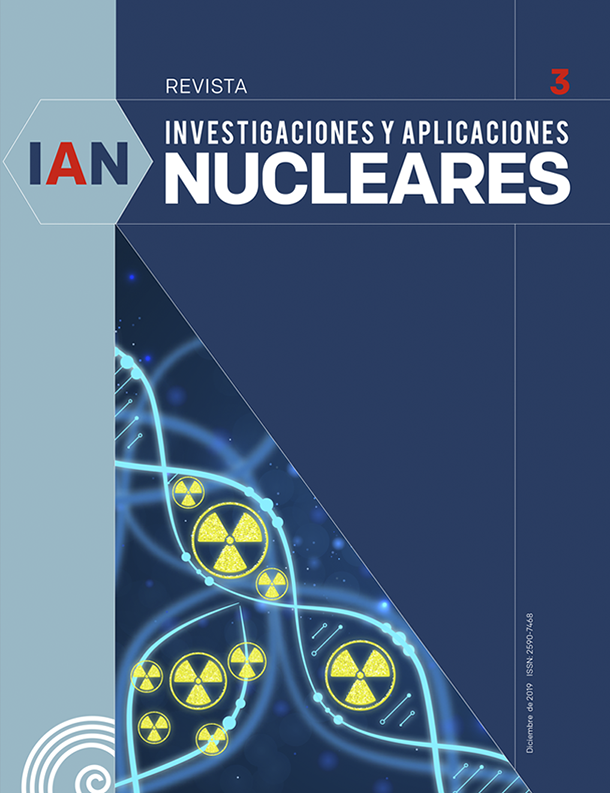Results and interpretation for the application of the risk matrix method in brachytherapy
DOI:
https://doi.org/10.32685/2590-7468/invapnuclear.3.2019.506Keywords:
risk assessment, brachytherapy, radiological safetyDownloads
How to Cite
Issue
Section
Published
Abstract
The objective of this study is to present the results obtained with the risk matrix method using the SEVRRA application in brachytherapy and the precautions that should be taken when applying this approach and interpreting the results. Risk analysis was performed for a high-dose-rate brachytherapy facility using the SEVRRA software and a tool developed based on the risk matrix method in a spreadsheet. The results of the second screening showed discrepancies between the risk profiles obtained with the SEVRRA application and with the custom tool. The percentages of high-risk initiating events obtained with the SEVRRA application and the custom tool were 6% and 14%, respectively. After analysis of each event, it was observed that discrepancies occur because the weighting of the robustness of the safety barriers in SEVRRA is inconsistent with that defined in the risk matrix method. These results have profound implications regarding the risk acceptability set in the method. Additionally, it was found that the risk matrix method does not consider the risks inherent to practice. Despite the observed inconsistencies, the potential of the SEVRRA application for risk assessment of radiotherapy facilities is recognized, given that this application is easy to use; however, review of the robustness of certain barriers to obtain the risk profile according to the risk matrix method is recommended. Based on the results, it will be possible to prioritize measures that must be adopted to guarantee the radiological safety of radiotherapy facilities.
References
.[1] S. C. B. Esteves, A. C. Z. de Oliveira, and L. F. de A. Feijó, “Braquiterapia de alta taxa de dose no Brasil,” Radiologia Brasileira, vol. 37, no. 5, pp. 337-341, 2004. https://doi.org/10.1590/S0100-39842004000500007
.[2] IAEA, Radiation protection and safety of radiation sources: International basic safety standards. IAEA Safety Standards Series No. GSR, Part 3, Viena: IAEA, 2014.
.[3] Ministerio de Minas y Energía (Colombia), Resolución 90874 de 2014. https://www.minenergia.gov.co/documents/10192/0/90874.pdf/ba4e5ee5-dc42-41d0-8593-1f83fa59f3b4
.[4] IAEA, Aplicación del método de matriz de riesgo a la radioterapia. Viena: IAEA-TECDOC 1685/S, Organismo Internacional de Energía Atómica, 2010. Disponible en: https://www-pub.iaea.org/MTCD/Publications/PDF/TE_1685_S_CD/PDF/Appendix.pdf
.[5] D. H. Stamatis, Failure modes and effects analysis. Milwaukee, WI: American Society for Quality Control, 1995.
.[6] P. Ortiz López, “Tools for risk assessment in radiation therapy,” Annals of the ICRP, vol. 41, no. 3-4, pp. 197-207, Oct. 2012. https://doi.org/10.1016/j.icrp.2012.06.025
.[7] IAEA, Case studies in the application of probabilistic safety assessment: Techniques to radiation sources. IAEA TECDOC, no. 1494. Viena: International Atomic Energy Agency, 2006.
.[8] IAEA, Análisis probabilista de seguridad de tratamientos de radioterapia con acelerador lineal. IAEA TECDOC, no. 1670/S. Viena: International Atomic Energy Agency, 2012.
.[9] Foro Iberoamericano de Organismos Reguladores y Nucleares, “SEVRRA”. [Online]. Disponible en https://www.foroiberam.org/sevrra. (Consultado en 2018).
.[10] D. J. McDonnell, S. B. Papadópulos, A. B. Paz, R. López Morones y F. Ramírez Pérez, “Aplicación de SEVRRA para la evaluación de condiciones de riesgo en braquiterapia HDR”, Presentado en el IX Congreso Regional de Seguridad Radiológica y Nuclear. Río de Janeiro, Brasil, 15 al 19 de abril, 2013.
.[11] C. Duménigo et al., “Application of the risk matrix approach in radiotherapy: An Ibero-American experience”. Presentado en el Foro Iberoamericano de Organismos Reguladores Radiológicos y Nucleares, 2014.
.[12] IAEA, Lessons learned from accidental exposures in radiotherapy. SRS n.° 17. Viena: Organismo Internacional de Energía Atómica, 2002.
.[13] M. Arciniegas Álvarez, D. C. Herrera, J. A. Gómez y A. Estrada Molina, “Análisis de riesgo de instalaciones de radioterapia y medicina nuclear en Colombia con el método de matriz de riesgo”. Presentado en el XI Congreso Regional de Seguridad Radiológica y Nuclear, La Habana, Cuba, 16-20 de abril, 2018.
.[14] IAEA, Aplicación del método de matriz de riesgo a la radioterapia. IAEA-TECDOC 1685/S: Apéndices. Viena: Organismo Internacional de Energía Atómica, 2012.







